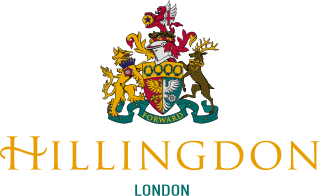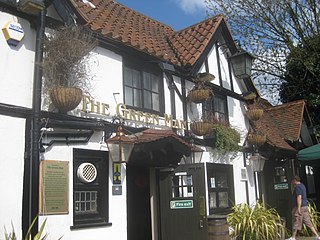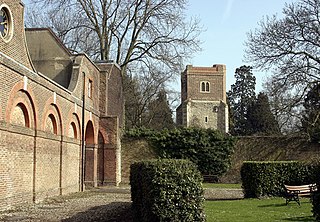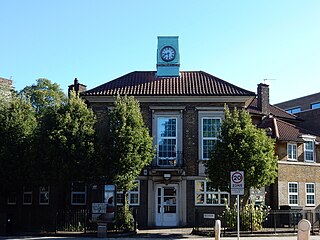Extent and development
By the 1910s the amenities of Heathrow had grown little since the, at latest, 15th-century laying out of the lane. [1]
It spanned, north–south, from Kings Arbour orchard to Perry Oaks farm (which sat at the junction of the lane and another). [2] An agricultural cluster of buildings and great house Heathrow Hall were slightly toward the north of the lane. All the homes and farms clung to this 90° turning lane, a turn staggered by two bends. Detailed 1910s maps show its unusual continuing agricultural focus so close to London; about half of the buildings and homes were at the two farms. [2] The northern was Heathrow Hall, 500 metres south of the area of Harmondsworth that was from the 16th century until the mid 20th century known as The Magpies, [n 1] a mix of terraces and houses on and off of the Bath Road, the west of which was a set of 18 densely packed houses, Belch's Row and the east of which was Sipson Green, further orchard-backed homes along the Bath Road in the same parish. [2] Heathrow itself had no terraces, instead small cottages and a few larger houses in large grounds. [2] Two offshoot lanes broke away, Cain's Lane southeast to New Bedfont and High Tree Lane south to West Bedfont (long part of Stanwell); at the start of Cain's Lane was in the 1910s an Anglican Mission room in the heart of the orchards and fields of Perrotts Farm, the other main cluster of buildings of Heathrow. [2] The Diocese of London was keen to give all people a convenient place of worship. By the end of the 19th century The Magpies had a mission church, on the north side of the Bath Road. [2] Sipson Green is covered in the text on the hamlet-turned-village of Sipson. Both remain intrinsic parts of the ecclesiastical parish of Harmondsworth, whose parish priest is as at 2024Ven. Amatu Onundu Christian-Iwuagwu in a church with elements surviving from initial 1067 construction. [3] It will be re-sited or see elements curated in a museum if a third runway for Heathrow Airport receives final planning permission and all appeals are dismissed. [4]
Founding and early history
A sizeable Neolithic settlement is believed to have been in the Heathrow area. Many artefacts have been found in the gravel around what is now the airport, and the Colne Valley regional park. [5] Waste pits filled with struck flint, arrowheads and fragments of pottery were also found in the area, indicating a settlement, though none other remains of such a settlement. [6]
Heathrow was one of the last settlements formed in the parish of Harmondsworth. [7] : 16 [8] : 19 [9] Its name was rendered in various orthographies which reflect approximately the same pronunciation as today La Hetherewe (about year 1410, first known mention), Hithero, Hetherow, Hetherowfeyld, Hitherowe, and Heath Row/Heathrow, Middle English spellings of "heath row" (simply a row (impliedly of houses) on or by a heath). Old maps show Heathrow as a row of houses along the northwest sides of the curve of a lane occasionally named Heathrow Road or Lane, which faced land until 1819 part of a great set of common lands belonging to neighbouring parishes — Hounslow Heath. The first orthography as "Heathrow" dates to 1453. [8] [7]
- Sipson Green earthworks
Certain Ordnance Survey maps before the Second World War, closer to Sipson Green and the adjoining Harlington Corner (localities of the Bath Road), show an earthwork, 300 metres due south of where New Road, Harlington meets the Bath Road, that had been excavated in 1723 by order of William Stukeley. He believed it to have been a Roman settlement, and named it "Caesar's Camp". [10] [2]
Development
Agriculture became the main source of income for residents in the hamlet, as the brickearth just as the underlying gravel in soils in the area made for reliable farming for fruit trees and bushes, vegetables, and flowers as it held manure well and markets were in easy reach of these perishable cash crops. Clay soil in other parts of England favoured potatoes and chalk favoured grains. Most residents and seasonal labourers joined in the large west Middlesex market gardening industry. Many residents grew which they would travel with into London to sell, on the return journey collecting manure for farming. [8] : 32 [7] : 18 [9] As motor vehicles made urban horse manure (from stables and cleaned off roads) much less, local farm workers started instead using sewage sludge (up to 50 long tons per acre (130 t/ha) annually) from the Perry Oaks sewage works, opened in 1936, as fertiliser.
The farms and buildings across most of south-east Harmondsworth greatly changed in the early 20th century; mostly a web of rural roads and lanes. An illustration being that until about 1930, only one building stood on the north side of Bath Road between Belches Row at The Magpies [n 1] on the two kilometres to the demolished Kings Head west of the preserved Longford Pump, Longford. [n 2] Three factories: Technicolor and Penguin Books and Black & Decker were founded in those fields before 1939. [13] [14] No buildings equally stood on the south side of this major thoroughfare. [n 3]
Other than a few homes and gardens, six farms held land which became the airport in the 1930s, as documented in principal feature maps. [15]
Heathrow was away from main roads and further away from railways; that kept it secluded and quiet although near London. As Middlesex changed to market gardening and fruit growing to supply expanding London, parts of Heathrow held on to old-type mixed farming, and thus was chosen for Middlesex area horse-drawn ploughing competitions, which needed land which was under stubble after harvest.
The ford where High Tree Lane crossed the Duke of Northumberland's River was a scenic spot used sometimes for picnics and courting couples. There was a footpath along beside the river from the ford to Longford.
The Middlesex Agricultural and Growers' Association held annual ploughing matches in Heathrow, until the last, the 99th, was held on 28 September 1937; [7] : 20 [8] : 33 the 100th match (in 1938) was postponed to 1939 due to severe drought, and in 1939 it was cancelled because World War II had started.
The Royal Commission on Historic Monuments listed 28 historically significant buildings in the parish of Harmondsworth, a third of which were in Heathrow. [7] : 33 Notable buildings included Heathrow Hall, a late 18th-century farmhouse, which was on Heathrow Road, [16] and Perry Oaks farm, which was Elizabethan.
In the 19th century much brickearth-type land in west Middlesex, including in Heathrow, was used for orchards of fruit trees, often several sorts mixed in one orchard. Much soft fruit was grown, often in the orchards under the fruit trees. Sometimes vegetables, or flowers for cutting, were grown under the fruit trees. An author in 1907 [17] reported "thousands and thousands" of plum, cherry, apple, pear, and damson trees, and innumerable currant and gooseberry bushes, round Harmondsworth and Sipson and Harlington and Heathrow. [8] : 31 After World War I the amount of fruit growing in the area decreased due to competition from imports and demand for more market-gardening land, and by 1939 less than 10% of the orchard area was left.
Produce was taken to Covent Garden market, or by smaller growers to Brentford market, which was nearer but less profitable. From the Three Magpies, the lane's northern end – much reduced and curtailed today – to Covent Garden is 14 miles (23 km) which was about 6 hours at laden horse-and-wagon speed; goods had to set off before 10 pm the day before to reach the market when it opened at 4 am, [8] : 33 until motor trucks came. Lighter produce such as strawberries where freshness brought highest prices could reach Covent Garden Market in an hour and a half in a light vehicle behind a light fast horse.
An 11.93-acre (4.83 ha) field south of the Bath Road, about 600 yards (550 m) east of the lane, were between after 1912 and 1935 allotment gardens (shown on a map dated 1935) and in the 1940 Luftwaffe air survey. [8] : 14 [18]
In the 1930s Heathrow Hall and Perry Oaks were mixed farms with wheat, cattle, sheep and pigs, and the other farms were largely market gardening and fruit growing. Photographs from early in the 20th century show to the southeast, at Cain's Farm facing modest Heathrow House, milk cattle (about 22 in the photograph) and the yearly horse-drawn ploughing competition on Cain's Lane. Later examples show such competitions in the far north-east near Tithe Barn Lane on Heathrow Hall land. In the 1910s a small gravel pit of just under an acre was on the east side of Tithe Barn Lane at the far west of what could be loosely, based mainly on Heathrow Hall's ownership be considered part of Heathrow and a similar marsh then pond to the north, all where today's Compass Centre stands. [n 1]






















